Menu
-
- Home
-
About Us
-
The Approach
-
Linking Language & Literacy
-
MindWing Learning
-
Learning Resources
-
SHOP
-
Blog
-
- About MindWing
- Our People
- Contact Us
- Your Account
- Login
-
Spain (EUR €)


Organizing Your SGM Materials for the New School Year
June 10, 2016
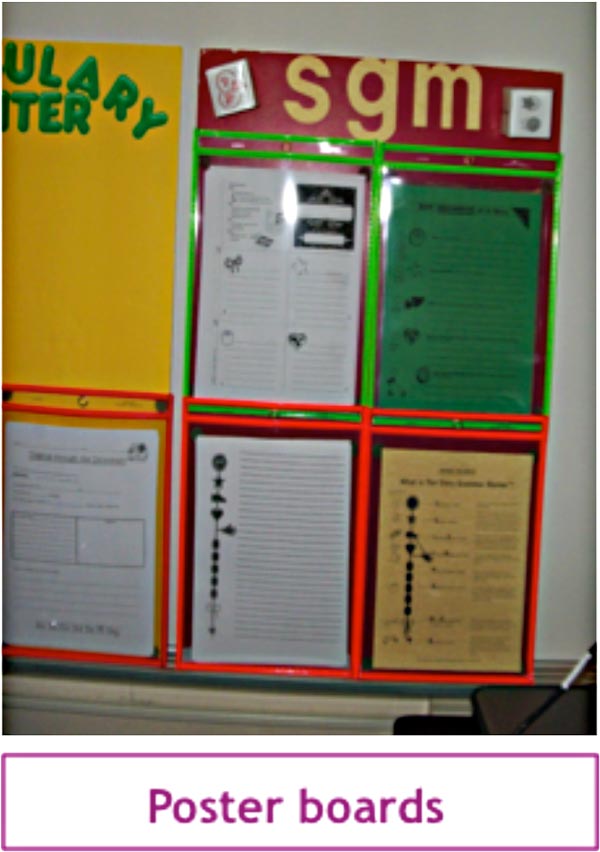 As another school year winds down, I am reminded of what I always loved about teaching: There was always another year to plan to engage children, change approaches, learn new techniques, and grow as a professional!
As another school year winds down, I am reminded of what I always loved about teaching: There was always another year to plan to engage children, change approaches, learn new techniques, and grow as a professional!
As you pack up supplies and begin a few weeks of rest, file this idea away with your materials to consider implementing next year. This picture is an idea that Natalia Kofman, a colleague of mine in Westfield, MA, used to organize her SGM® materials in her fourth grade classroom...

Recognizing Feelings: Recycle Your Iced Tea Containers for a Cool Summer Activity
June 07, 2016
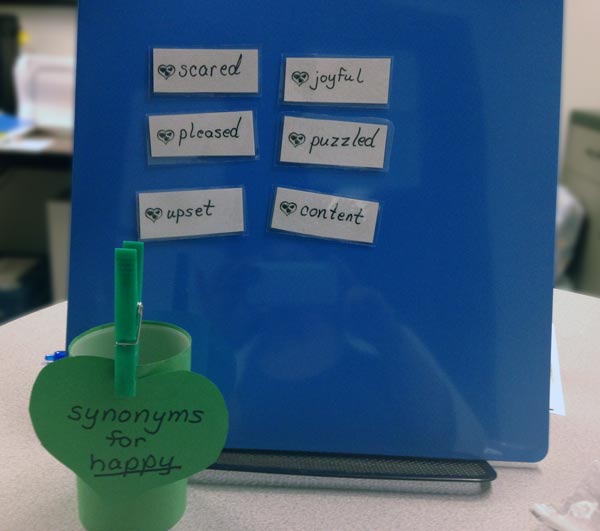 As you sip your iced tea on a hot summer day over the next couple of months, think about saving your iced tea containers for this very cool lesson and activity. It focuses on explicitly teaching how to recognize feelings and emotions in literature and in life. The explicit teaching of recognizing feelings in literature and in our interactions with others is imperative in our schools and in life. The above standards and quotes emphasize the importance of our need to help students identify feelings, recognize them in others, and make the connection to critical thinking and inference via the Critical Thinking Triangle. The SGM iconic structure is a concrete way to develop this necessity...
As you sip your iced tea on a hot summer day over the next couple of months, think about saving your iced tea containers for this very cool lesson and activity. It focuses on explicitly teaching how to recognize feelings and emotions in literature and in life. The explicit teaching of recognizing feelings in literature and in our interactions with others is imperative in our schools and in life. The above standards and quotes emphasize the importance of our need to help students identify feelings, recognize them in others, and make the connection to critical thinking and inference via the Critical Thinking Triangle. The SGM iconic structure is a concrete way to develop this necessity...

Maryellen’s Analysis of 5th-Grade Writing Sample
May 31, 2016
 This next written retell of Too Many Tamales is by Ray, a student in Grade 5. We’ve included a typed version of his writing, an analysis and a conference suggestion for use during the Writing Process. The descriptive details in Emma’s writing (see May 13 blog) and the use of story grammar components indicating advancing structure and content are evident—but to a lesser degree—in Ray’s sample.
This next written retell of Too Many Tamales is by Ray, a student in Grade 5. We’ve included a typed version of his writing, an analysis and a conference suggestion for use during the Writing Process. The descriptive details in Emma’s writing (see May 13 blog) and the use of story grammar components indicating advancing structure and content are evident—but to a lesser degree—in Ray’s sample.

Analyze 5th Grade Writing
May 24, 2016
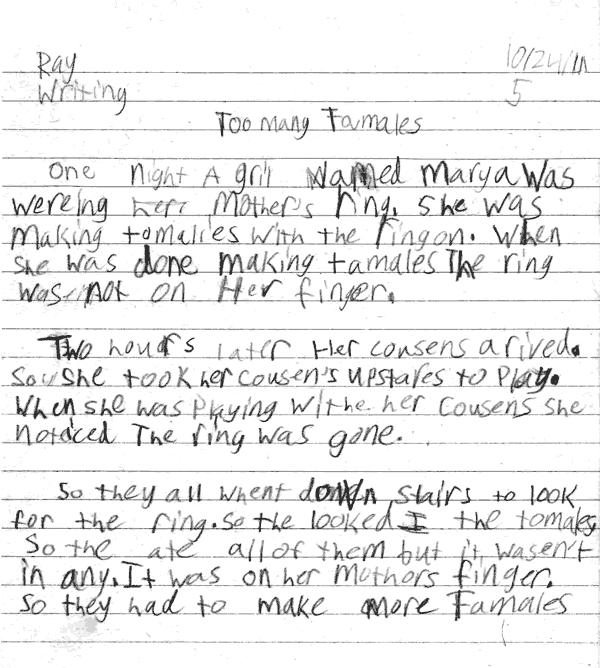 Recent blogs showed Maryellen’s analysis of a third-grade written retelling of Too Many Tamales. Included in those blogs is a copy of the actual sample, a typed version of the sample, an analysis, and conferencing suggestions to use during the Writing Process. In this new blog, we look at another sample of a written retelling of Too Many Tamales; this time from a fifth-grade student, Ray. We invite you to analyze his writing and at the end of this week, Maryellen will provide her analysis and talking points for conferencing.
Recent blogs showed Maryellen’s analysis of a third-grade written retelling of Too Many Tamales. Included in those blogs is a copy of the actual sample, a typed version of the sample, an analysis, and conferencing suggestions to use during the Writing Process. In this new blog, we look at another sample of a written retelling of Too Many Tamales; this time from a fifth-grade student, Ray. We invite you to analyze his writing and at the end of this week, Maryellen will provide her analysis and talking points for conferencing.

Magnetic Spinner Activity for Narrative & Expository Text Questions
May 20, 2016
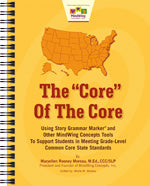 In today’s classrooms, students are being asked to comprehend more complex materials in earlier grades with a particular emphasis on expository texts. The blending of both narrative and expository texts in many reading selections make understanding these structures a cornerstone for student comprehension success. The iconic structure of the SGM® provides a concrete visual and tactile scaffold to teach these structures to children. The expository text structures “tie in” to the narrative sequence. The “Core” of the Core manual explains this connection in detail showing how each narrative stage facilitates thinking about information (expository) structures.
In today’s classrooms, students are being asked to comprehend more complex materials in earlier grades with a particular emphasis on expository texts. The blending of both narrative and expository texts in many reading selections make understanding these structures a cornerstone for student comprehension success. The iconic structure of the SGM® provides a concrete visual and tactile scaffold to teach these structures to children. The expository text structures “tie in” to the narrative sequence. The “Core” of the Core manual explains this connection in detail showing how each narrative stage facilitates thinking about information (expository) structures.

Tech Tuesday: Chapter Books and Stickwriting, a Complementary Visual Strategy
May 17, 2016
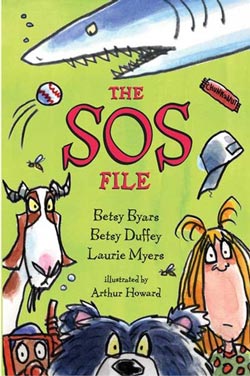 Using chapter books, which provide richer and yet more difficult narratives older students must tackle, has been a focus of the MindWing Blog this school year. In several of my posts, I have discussed tech-related avenues to getting the context of chapter books your students may be reading in class (to serve as topics for narrative intervention activities with SGM®), as well as apps that can visually represent the Critical Thinking Triangle®, a great support to review the narrative gist of chapters within a book. In this post, we are going to take a look at a great chapter book to use along with SGM®, The SOS File by Betsy Byars, Betsy Duffy, and Laurie Myers, along with a strategy that aligns with narrative intervention, Stickwriting, or representing narrative elements through quick sketches...
Using chapter books, which provide richer and yet more difficult narratives older students must tackle, has been a focus of the MindWing Blog this school year. In several of my posts, I have discussed tech-related avenues to getting the context of chapter books your students may be reading in class (to serve as topics for narrative intervention activities with SGM®), as well as apps that can visually represent the Critical Thinking Triangle®, a great support to review the narrative gist of chapters within a book. In this post, we are going to take a look at a great chapter book to use along with SGM®, The SOS File by Betsy Byars, Betsy Duffy, and Laurie Myers, along with a strategy that aligns with narrative intervention, Stickwriting, or representing narrative elements through quick sketches...
